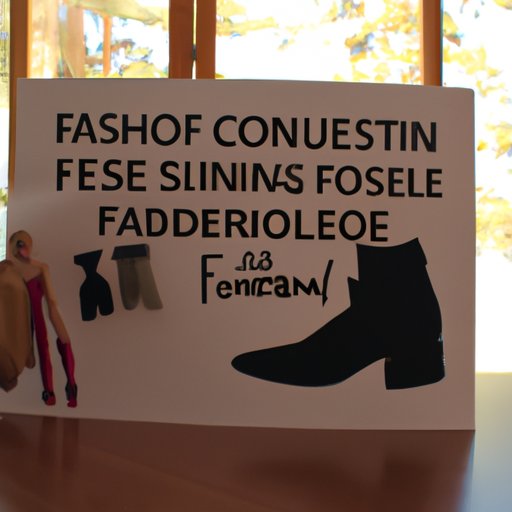Introduction
Fast fashion is a term used to describe low-cost clothing produced quickly and cheaply to keep up with the latest trends. It has become increasingly popular over the past few decades due to its affordability and accessibility, but it has also had a significant negative impact on both the environment and workers’ rights. This article will explore ways to make fast fashion more sustainable, such as educating consumers, increasing transparency in manufacturing processes, promoting sustainable fabric alternatives, encouraging responsible consumption habits, developing garment recycling programs, and investing in sustainable technologies and materials.

Educate Consumers on the Impact of Fast Fashion
In order to make fast fashion more sustainable, it is important to educate consumers on the negative impacts it can have. By raising awareness of the environmental and social costs of fast fashion, people may be more likely to make conscious decisions when shopping.
Explain How Fast Fashion Impacts the Environment
The production of fast fashion has a huge environmental impact, from the manufacture of the fabrics used to the disposal of the garments. Many of the fabrics used are made from synthetic materials that are not biodegradable, meaning they can take hundreds of years to break down. In addition, the production process often involves the use of large amounts of water, energy, and chemicals, which can lead to air and water pollution. Finally, the disposal of clothing is a major issue, as much of it ends up in landfills or incinerators.
Describe How Fast Fashion Affects Workers’ Rights
The production of fast fashion is often carried out in countries with little regulation or labor laws, meaning workers are often subject to poor working conditions and low wages. In addition, many brands do not provide adequate safety equipment or training, leading to an increased risk of injury and illness for workers. Furthermore, workers are often subjected to long hours and forced overtime, with little to no rest days.
Show Consumers What Their Purchases Support
It is important for consumers to understand the impacts of their purchases and how their money is being used. By showing them what their money is supporting, they may be more likely to make more ethical choices when shopping. This could include providing information about where and how garments are made, as well as what kind of working conditions and wages are involved.

Increase Transparency in Manufacturing Processes
Consumers have a right to know where and how their clothes are made, and it is important for brands to be transparent about their manufacturing processes. This will help to ensure that workers’ rights are being respected and that the environment is being protected.
Investigate Where and How Garments Are Made
Brands should investigate where and how their garments are made, and ensure that workers’ rights are respected and that environmental regulations are being followed. This could involve visiting factories to ensure standards are being met, as well as conducting audits of suppliers to make sure they are adhering to ethical production practices.
Implement Policies for Ethical Production Practices
Once a brand has identified where and how its garments are made, it should develop and implement policies for ethical production practices. This could include ensuring that workers are paid a living wage, provided with safe working conditions, and given adequate training and safety equipment. It could also involve setting limits on the use of water, energy, and chemicals during the production process.
Demand Transparency from Brands
Finally, consumers should demand transparency from brands, and hold them accountable for their production processes. This could involve asking questions about where and how garments are made, or requesting proof that ethical production practices are being followed. Consumers should also be wary of brands that are unwilling to provide this information.
Promote Sustainable Fabric Alternatives
One way to make fast fashion more sustainable is to promote the use of sustainable fabrics. These fabrics are made from natural materials that can be broken down easily and are less harmful to the environment.
Explain Different Types of Sustainable Fabrics
There are various types of sustainable fabrics available, including organic cotton, hemp, linen, bamboo, and Tencel. These fabrics are made from natural materials and require fewer resources to produce than synthetic fabrics. They are also biodegradable and recyclable, making them better for the environment.
Highlight Positive Environmental Impacts of Sustainable Fabrics
It is important to highlight the positive environmental impacts of sustainable fabrics. For example, organic cotton uses less water and energy to produce, while hemp and bamboo require fewer pesticides and fertilizers. In addition, these fabrics are biodegradable, meaning they can break down naturally and be reused or recycled.
Showcase Examples of Brands Utilizing Sustainable Fabrics
Finally, it is important to showcase examples of brands utilizing sustainable fabrics. This will encourage other brands to follow suit and help to create a shift towards more sustainable fashion.
Encourage Responsible Consumption Habits
In order to reduce the environmental and social impacts of fast fashion, it is important to encourage responsible consumption habits. This could involve buying fewer items, buying second-hand, and extending the lifespan of clothing.
Explain Why People Should Buy Less
It is important to explain why people should buy less, and emphasize the benefits of reducing consumption. Buying fewer items means less waste, fewer resources used, and less money spent. It also encourages people to think more carefully about what they purchase and only buy items they truly need or love.
Suggest Ways to Reduce Clothing Waste
It is also important to suggest ways to reduce clothing waste. This could include donating unwanted items to charity shops, selling them online, or swapping them with friends and family. It is also important to note that buying second-hand is a great way to reduce waste and save money.
Discuss Ways to Extend the Lifespan of Clothing
Finally, it is important to discuss ways to extend the lifespan of clothing. This could include washing clothes less frequently, repairing damaged items, and storing them properly. It is also important to note that buying higher quality items can also help to prolong their lifespan.
Develop Garment Recycling Programs
Garment recycling is another way to make fast fashion more sustainable. By creating garment recycling programs, brands can reduce their environmental impact and keep clothing out of landfills.
Explain the Benefits of Garment Recycling
It is important to explain the benefits of garment recycling, such as reducing waste, conserving resources, and saving money. Garment recycling also helps to reduce the need for new fabrics, as recycled fabrics can be used in the production of new garments.
Describe the Different Types of Garment Recycling Programs
It is also important to describe the different types of garment recycling programs. These could include take-back programs, which allow customers to return garments to the store; donation programs, which donate unwanted items to charity; and resale programs, which resell gently used items at discounted prices.
Highlight Examples of Successful Garment Recycling Programs
Finally, it is important to highlight examples of successful garment recycling programs. This could include showcasing brands that have implemented take-back programs, donation programs, or resale programs. It is also important to note that some brands are even using recycled fabrics in their production processes.
Support Fair Labor Practices
In order to make fast fashion more sustainable, it is important to support fair labor practices. This includes ensuring that workers are paid a living wage and provided with safe working conditions.
Explain What Fair Labor Practices Mean
It is important to explain what fair labor practices mean and why they are important. This could include discussing topics such as minimum wages, working hours, overtime pay, and health and safety regulations.
Identify Organizations Promoting Fair Labor Practices
It is also important to identify organizations that are promoting fair labor practices. This could include international organizations such as the International Labour Organization (ILO), as well as local organizations that are working to improve the lives of workers.
Provide Tips on How Consumers Can Support Fair Labor Practices
Finally, it is important to provide tips on how consumers can support fair labor practices. This could include researching brands to make sure they adhere to fair labor practices, asking questions about where and how garments are made, and supporting organizations that are promoting fair labor practices.
Invest in Sustainable Technologies and Materials
Finally, it is important for brands to invest in sustainable technologies and materials. These technologies and materials can help to reduce the environmental impacts of fast fashion and make production processes more efficient.
Explain What Sustainable Technologies and Materials Are
It is important to explain what sustainable technologies and materials are and how they can help to make fashion more sustainable. This could include discussing topics such as energy efficiency, water conservation, and the use of recycled materials.
Describe Examples of Sustainable Technologies and Materials
It is also important to describe examples of sustainable technologies and materials. This could include discussing topics such as solar power, LED lighting, and the use of natural dyes. It is also important to note that some brands are even using upcycled materials in their production processes.
Highlight Companies Utilizing Sustainable Technologies and Materials
Finally, it is important to highlight companies that are utilizing sustainable technologies and materials. This could include showcasing brands that have implemented energy-efficient technologies or are using recycled or upcycled materials in their production processes.
Conclusion
In conclusion, there are a number of ways to make fast fashion more sustainable, such as educating consumers, increasing transparency in manufacturing processes, promoting sustainable fabric alternatives, encouraging responsible consumption habits, developing garment recycling programs, and investing in sustainable technologies and materials. By implementing these solutions, we can reduce the environmental and social impacts of fast fashion and create a more sustainable future.
Summary of Key Points
This article explored ways to make fast fashion more sustainable, such as educating consumers, increasing transparency in manufacturing processes, promoting sustainable fabric alternatives, encouraging responsible consumption habits, developing garment recycling programs, and investing in sustainable technologies and materials.
Call to Action for Consumers
Consumers can help to make fast fashion more sustainable by educating themselves on the impacts of their purchases, demanding transparency from brands, buying fewer items, buying second-hand, and supporting organizations that promote fair labor practices.
Resources for Further Learning
For more information on making fast fashion more sustainable, visit the following websites:
- What is Fast Fashion?
- How to Make Fast Fashion Sustainable
-
(Note: Is this article not meeting your expectations? Do you have knowledge or insights to share? Unlock new opportunities and expand your reach by joining our authors team. Click Registration to join us and share your expertise with our readers.)
